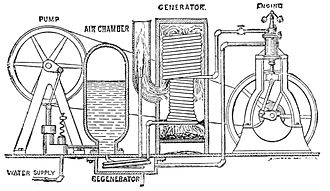directly upon the point of cut-off as in the best machines of large power. It is placed inside the belt-pulley, and dispenses with the ordinary belt, thereby avoiding the danger of the engine racing through the breaking or slipping of the belt. The balls are two heavy weights revolving with the belt-pulley, and balanced by spiral springs. They are free to move in the direction of the radius of the wheel to and from the center, and, as they do so under variations of speed, they operate the cut-off mechanism in a simple manner. The working of this governor has been found very satisfactory in use, and it seems to be well suited to engines of larger power. This engine is made in sizes of one half, one, one and a half, two, and two and a half horse-power, and up to five horse, while the pumping-engine is made of a capacity of from two hundred and fifty to fifteen hundred gallons per hour, raised one hundred feet high. The former amount is pumped with an expenditure of twenty-five feet of gas an hour. These engines have been on the market some five years, and have been found very satisfactory in use.
An engine of very much smaller power, and quite novel construction, the invention of Mr. Charles Tyson, has very recently been brought out, which seems to be well adapted to driving such light machinery as sewing and knitting machines, lathes, scroll-saws, fans, coffee-mills, etc. It is quite safe, requires but little care, does not easily get out of order, and can be managed by any one capable of using a sewing-machine. It is ornamental in design and handsomely finished, fitting it to be used in any room of a dwelling that is convenient. Those at present made are of about one quarter of a man-power (one thousand foot-pounds per minute), but larger sizes, adapted to a greater range of
Fig. 6.

work, will probably be built should the present machine prove satisfactory in use. Gas is used as fuel, but they can be made to burn either coal, wood, or oil. The construction and method of generating steam are such that an explosion can not occur, and the steam-gauge, water-gauge, and safety-valve are therefore dispensed with, with the advantage of considerably lessening the cost. The idea carried out in the construction of this engine is that of converting the water into steam in
